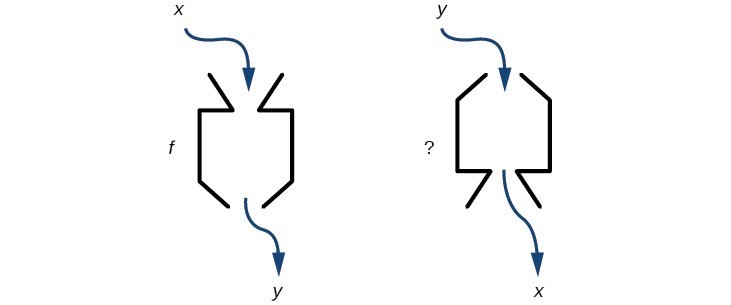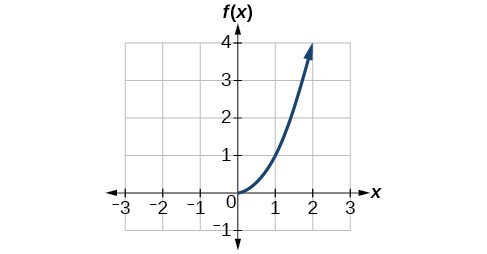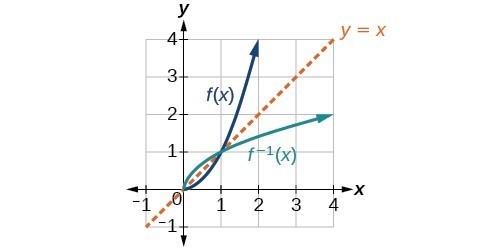Inverse Functions
A reversible heat pump is a climate-control system that is an air conditioner and a heater in a single device. Operated in one direction, it pumps heat out of a house to provide cooling. Operating in reverse, it pumps heat into the building from the outside, even in cool weather, to provide heating. As a heater, a heat pump is several times more efficient than conventional electrical resistance heating.
If some physical machines can run in two directions, we might ask whether some of the function "machines" we have been studying can also run backwards. Figure 1 provides a visual representation of this question. In this section, we will consider the reverse nature of functions. Figure 1. Can a function "machine" operate in reverse?
Figure 1. Can a function "machine" operate in reverse?Characteristics of Inverse Functions
Suppose a fashion designer traveling to Milan for a fashion show wants to know what the temperature will be. He is not familiar with the Celsius scale. To get an idea of how temperature measurements are related, he asks his assistant, Betty, to convert 75 degrees Fahrenheit to degrees Celsius. She finds the formula and substitutes 75 for to calculate . Knowing that a comfortable 75 degrees Fahrenheit is about 24 degrees Celsius, he sends his assistant the week’s weather forecast for Milan, and asks her to convert all of the temperatures to degrees Fahrenheit.
At first, Betty considers using the formula she has already found to complete the conversions. After all, she knows her algebra, and can easily solve the equation for after substituting a value for . For example, to convert 26 degrees Celsius, she could write
Knowing that a comfortable 75 degrees Fahrenheit is about 24 degrees Celsius, he sends his assistant the week’s weather forecast for Milan, and asks her to convert all of the temperatures to degrees Fahrenheit.
At first, Betty considers using the formula she has already found to complete the conversions. After all, she knows her algebra, and can easily solve the equation for after substituting a value for . For example, to convert 26 degrees Celsius, she could write
After considering this option for a moment, however, she realizes that solving the equation for each of the temperatures will be awfully tedious. She realizes that since evaluation is easier than solving, it would be much more convenient to have a different formula, one that takes the Celsius temperature and outputs the Fahrenheit temperature. The formula for which Betty is searching corresponds to the idea of an inverse function, which is a function for which the input of the original function becomes the output of the inverse function and the output of the original function becomes the input of the inverse function. Given a function , we represent its inverse as , read as " inverse of ." The raised is part of the notation. It is not an exponent; it does not imply a power of . In other words, does not mean because is the reciprocal of and not the inverse. The "exponent-like" notation comes from an analogy between function composition and multiplication: just as (1 is the identity element for multiplication) for any nonzero number , so equals the identity function, that is,
This holds for all in the domain of . Informally, this means that inverse functions "undo" each other. However, just as zero does not have a reciprocal, some functions do not have inverses. Given a function , we can verify whether some other function is the inverse of by checking whether either or is true. We can test whichever equation is more convenient to work with because they are logically equivalent (that is, if one is true, then so is the other.) For example, and are inverse functions.
and
A few coordinate pairs from the graph of the function are (−2, −8), (0, 0), and (2, 8). A few coordinate pairs from the graph of the function are (−8, −2), (0, 0), and (8, 2). If we interchange the input and output of each coordinate pair of a function, the interchanged coordinate pairs would appear on the graph of the inverse function.
A General Note: Inverse Function
For any one-to-one function , a function is an inverse function of if . This can also be written as for all in the domain of . It also follows that for all in the domain of if is the inverse of . The notation is read inverse." Like any other function, we can use any variable name as the input for , so we will often write , which we read as inverse of Keep in mind that and not all functions have inverses.Example: Identifying an Inverse Function for a Given Input-Output Pair
If for a particular one-to-one function and , what are the corresponding input and output values for the inverse function?Answer: The inverse function reverses the input and output quantities, so if
Alternatively, if we want to name the inverse function , then and .
Analysis of the Solution
Notice that if we show the coordinate pairs in a table form, the input and output are clearly reversed.Try It
Given that , what are the corresponding input and output values of the original functionAnswer:
How To: Given two functions and , test whether the functions are inverses of each other.
- Determine whether or .
- If either statement is true, then both are true, and and . If either statement is false, then both are false, and and .
Example: Testing Inverse Relationships Algebraically
If and , isAnswer:
so
This is enough to answer yes to the question, but we can also verify the other formula.
Analysis of the Solution
Notice the inverse operations are in reverse order of the operations from the original function.Try It
If and , isAnswer: Yes
Example: Determining Inverse Relationships for Power Functions
If (the cube function) and , isAnswer: No, the functions are not inverses.
Analysis of the Solution
The correct inverse to the cube is, of course, the cube root , that is, the one-third is an exponent, not a multiplier.Try It
If , isAnswer: Yes
Determine the Domain and Range of an Inverse Function
The outputs of the function are the inputs to , so the range of is also the domain of . Likewise, because the inputs to are the outputs of , the domain of is the range of . We can visualize the situation. Domain and range of a function and its inverse
Domain and range of a function and its inverse- The domain of = range of = .
- The domain of = range of = .
A General Note: Domain and Range of Inverse Functions
The range of a function is the domain of the inverse function . The domain of is the range of .How To: Given a function, find the domain and range of its inverse.
- If the function is one-to-one, write the range of the original function as the domain of the inverse, and write the domain of the original function as the range of the inverse.
- If the domain of the original function needs to be restricted to make it one-to-one, then this restricted domain becomes the range of the inverse function.
Example: Finding the Inverses of Toolkit Functions
Identify which of the toolkit functions besides the quadratic function are not one-to-one, and find a restricted domain on which each function is one-to-one, if any. The toolkit functions are reviewed below. We restrict the domain in such a fashion that the function assumes all y-values exactly once.| Constant | Identity | Quadratic | Cubic | Reciprocal |
| Reciprocal squared | Cube root | Square root | Absolute value | |
Answer: The constant function is not one-to-one, and there is no domain (except a single point) on which it could be one-to-one, so the constant function has no meaningful inverse. The absolute value function can be restricted to the domain , where it is equal to the identity function. The reciprocal-squared function can be restricted to the domain .
Analysis of the Solution
We can see that these functions (if unrestricted) are not one-to-one by looking at their graphs. They both would fail the horizontal line test. However, if a function is restricted to a certain domain so that it passes the horizontal line test, then in that restricted domain, it can have an inverse. (a) Absolute value (b) Reciprocal squared
(a) Absolute value (b) Reciprocal squaredTry It
The domain of function is and the range of function is . Find the domain and range of the inverse function.Answer: The domain of function is and the range of function is .
Define and Graph an Inverse
Once we have a one-to-one function, we can evaluate its inverse at specific inverse function inputs or construct a complete representation of the inverse function in many cases.Inverting Tabular Functions
Suppose we want to find the inverse of a function represented in table form. Remember that the domain of a function is the range of the inverse and the range of the function is the domain of the inverse. So we need to interchange the domain and range. Each row (or column) of inputs becomes the row (or column) of outputs for the inverse function. Similarly, each row (or column) of outputs becomes the row (or column) of inputs for the inverse function.Example: Interpreting the Inverse of a Tabular Function
A function is given below, showing distance in miles that a car has traveled in minutes. Find and interpret .| 30 | 50 | 70 | 90 | |
| 20 | 40 | 60 | 70 |
Answer: The inverse function takes an output of and returns an input for . So in the expression , 70 is an output value of the original function, representing 70 miles. The inverse will return the corresponding input of the original function , 90 minutes, so . The interpretation of this is that, to drive 70 miles, it took 90 minutes. Alternatively, recall that the definition of the inverse was that if , then . By this definition, if we are given , then we are looking for a value so that . In this case, we are looking for a so that , which is when .
Try It
Using the table below, find and interpret (a) , and (b) .| 30 | 50 | 60 | 70 | 90 | |
| 20 | 40 | 50 | 60 | 70 |
Answer: a. . In 60 minutes, 50 miles are traveled. b. . To travel 60 miles, it will take 70 minutes.
Evaluating the Inverse of a Function, Given a Graph of the Original Function
The domain of a function can be read by observing the horizontal extent of its graph. We find the domain of the inverse function by observing the vertical extent of the graph of the original function, because this corresponds to the horizontal extent of the inverse function. Similarly, we find the range of the inverse function by observing the horizontal extent of the graph of the original function, as this is the vertical extent of the inverse function. If we want to evaluate an inverse function, we find its input within its domain, which is all or part of the vertical axis of the original function’s graph.How To: Given the graph of a function, evaluate its inverse at specific points.
- Find the desired input on the y-axis of the given graph.
- Read the inverse function’s output from the x-axis of the given graph.
Example: Evaluating a Function and Its Inverse from a Graph at Specific Points
A function is given below. Find and .
Answer:
To evaluate , we find 3 on the x-axis and find the corresponding output value on the y-axis. The point tells us that .
To evaluate , recall that by definition means the value of x for which . By looking for the output value 3 on the vertical axis, we find the point on the graph, which means , so by definition, .

Try It
Using the graph in the previous example, (a) find , and (b) estimate .Answer: a. 3; b. 5.6
Finding Inverses of Functions Represented by Formulas
Sometimes we will need to know an inverse function for all elements of its domain, not just a few. If the original function is given as a formula—for example, as a function of we can often find the inverse function by solving to obtain as a function of .How To: Given a function represented by a formula, find the inverse.
- Make sure is a one-to-one function.
- Solve for .
- Interchange and .
Example: Inverting the Fahrenheit-to-Celsius Function
Find a formula for the inverse function that gives Fahrenheit temperature as a function of Celsius temperature.
Answer:
By solving in general, we have uncovered the inverse function. If
,
then.
In this case, we introduced a function to represent the conversion because the input and output variables are descriptive, and writing could get confusing.Try It
Solve for in terms of givenAnswer:
Example: Solving to Find an Inverse Function
Find the inverse of the function .Answer: So or .
Analysis of the Solution
The domain and range of exclude the values 3 and 4, respectively. and are equal at two points but are not the same function, as we can see by creating the table below.| 1 | 2 | 5 | ||
| 3 | 2 | 5 |
Example: Solving to Find an Inverse with Radicals
Find the inverse of the function .Answer: So . The domain of is . Notice that the range of is , so this means that the domain of the inverse function is also .
Analysis of the Solution
The formula we found for looks like it would be valid for all real . However, itself must have an inverse (namely, ) so we have to restrict the domain of to in order to make a one-to-one function. This domain of is exactly the range of .Try It
What is the inverse of the function ? State the domains of both the function and the inverse function.Answer:
Graph a Function's Inverse
Now that we can find the inverse of a function, we will explore the graphs of functions and their inverses. Let us return to the quadratic function restricted to the domain , on which this function is one-to-one, and graph it as below. Quadratic function with domain restricted to [0, ∞).
Quadratic function with domain restricted to [0, ∞). Square and square-root functions on the non-negative domain
Square and square-root functions on the non-negative domainExample: Finding the Inverse of a Function Using Reflection about the Identity Line
Given the graph of , sketch a graph of .
Answer: This is a one-to-one function, so we will be able to sketch an inverse. Note that the graph shown has an apparent domain of and range of , so the inverse will have a domain of and range of . If we reflect this graph over the line , the point reflects to and the point reflects to . Sketching the inverse on the same axes as the original graph gives us the result in the graph below.
 The function and its inverse, showing reflection about the identity line
The function and its inverse, showing reflection about the identity lineAny function , where is a constant, is also equal to its own inverse.
Key Concepts
- If is the inverse of , then
- .
- Each of the toolkit functions has an inverse.
- For a function to have an inverse, it must be one-to-one (pass the horizontal line test).
- A function that is not one-to-one over its entire domain may be one-to-one on part of its domain.
- For a tabular function, exchange the input and output rows to obtain the inverse.
- The inverse of a function can be determined at specific points on its graph.
- To find the inverse of a formula, solve the equation for as a function of . Then exchange the labels and .
- The graph of an inverse function is the reflection of the graph of the original function across the line .
Glossary
- inverse function
- for any one-to-one function , the inverse is a function such that for all in the domain of ; this also implies that for all in the domain of
